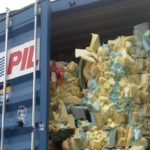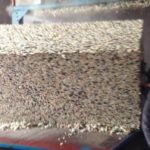The raw materials for the production of soft polyurethane sponges include three main ingredients: polyol, TDI and water. Water, which is the main element of life, expands and increases the volume of the sponge. During the production process, the raw materials are completely changed and the resulting compounds are transferred to a variable temperature between 20 and 25 degrees Celsius, which is the most suitable temperature for it, and polluted and harmful elements such as CFC and chloridemethylene are completely removed. In these stages, the polymerization reaction takes place for 20 seconds, during which the volume of the sponge block reaches a fixed size and when it exits the device, it is cut into different dimensions. During 72 hours after the production process, polyurethane interactions are finished and the blocks are stored in warehouses. Then the product can be supplied in block form or transferred to cutting sections.
Sponge is a material that is widely used in a multi-purpose way and has a high value. It can be used not only as a soft and flexible object but also as a rigid and strong material. The material has the ability to cut, angle and add one piece to another, and as a result, its use is very effective and desirable. The use of sponge in the preparation of cushions, backs, mattresses and pillows is very suitable for replacing and replacing the old types, and this product is widely used in all residential houses, from the bedroom to the basement, as well as in travel villas, camps, or recreational vehicles.
Density and compression:
When buying a sponge, two main issues of density and compression should be considered. Density refers to its weight, the sponge with higher density has better quality and therefore more endurance. The compression of the sponge is proportional to its softness and hardness, the higher the compression of the sponge, the higher the degree of hardness. You can choose the sponge that suits you in terms of compression.
The sponge or cloud is used in different thicknesses for most parts of the furniture. For example, thin sponges are placed for the handles of the sofa and the back of the sofa. In many cases, sponges known as 30 kg sponge or urethane sponge are used on furniture floors, which means 30 kg (in some cases 25 or 20 kg) density of the sponge. The higher the density of the sponge, the longer its life will be.



